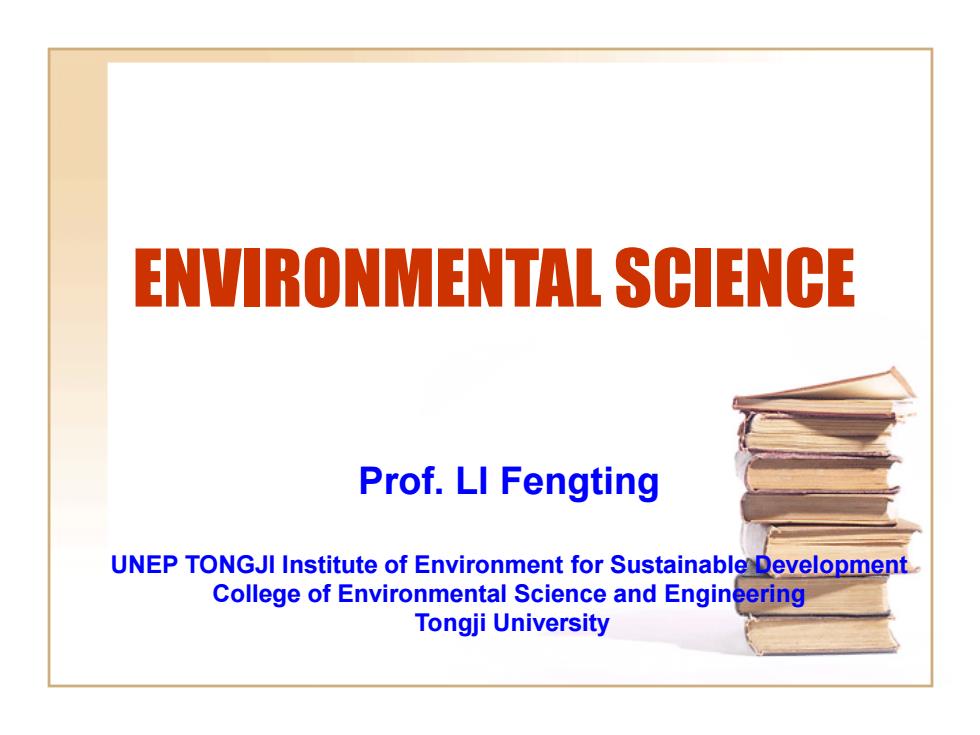
ENVIRONMENTAL SCIENGE Prof.LI Fengting UNEP TONGJI Institute of Environment for Sustainable Development College of Environmental Science and Engineering Tongji University
ENVIRONMENTAL SCIENCE Prof. LI Fengting UNEP TONGJI Institute of Environment for Sustainable Development College of Environmental Science and Engineering Tongji University
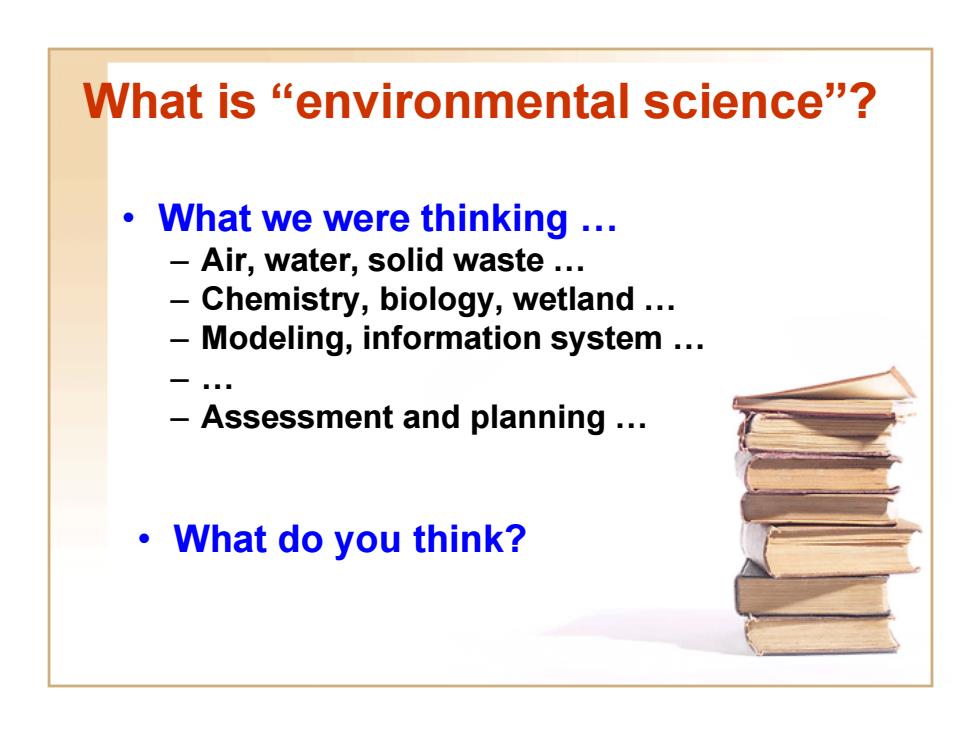
What is "environmental science"? What we were thinking .. -Air,water,solid waste... Chemistry,biology,wetland... Modeling,information system .. Assessment and planning .. ·What do you think?
What is “environmental science”? • What we were thinking … – Air, water, solid waste … – Chemistry, biology, wetland … – Modeling, information system … – … – Assessment and planning … • What do you think?

According to Wikipedia: Environmental science is an interdisciplinary academic field that integrates physical and biological sciences,(including physics,chemistry, biology,soil science,geology,and geography)to the study of the environment,and the solution of environmental problems.Environmental science provides an integrated, quantitative,and interdisciplinary approach to the study of environmental systems
According to Wikipedia: • Environmental science is an interdisciplinary academic field that integrates physical and biological sciences, (including physics, chemistry, biology, soil science, geology, and geography) to the study of the environment, and the solution of environmental problems. Environmental science provides an integrated, quantitative, and interdisciplinary approach to the study of environmental systems
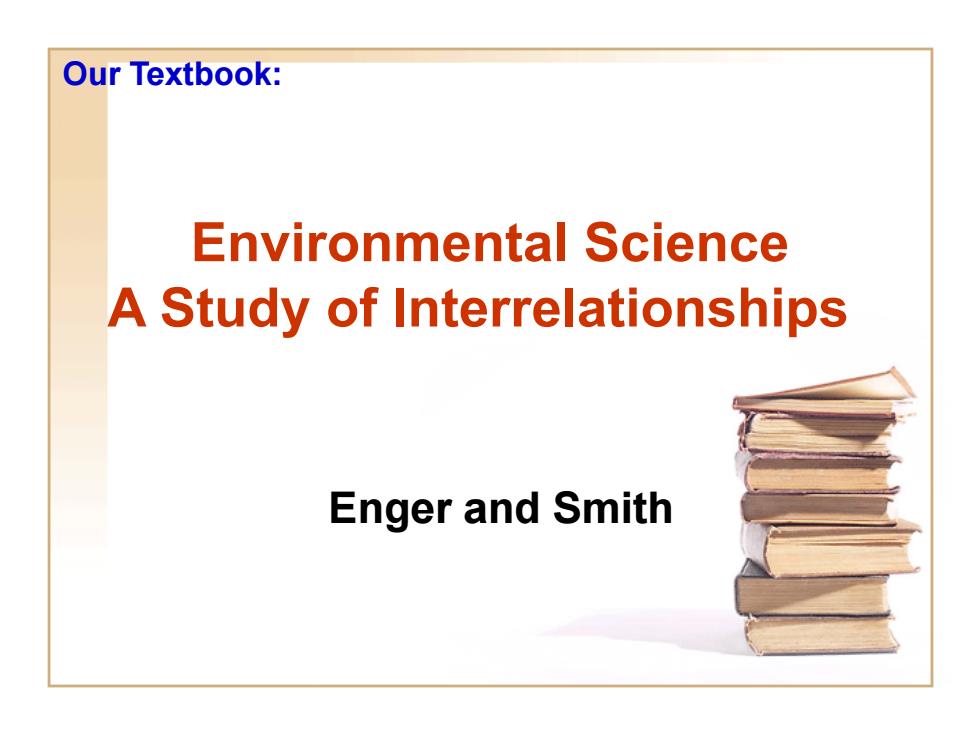
Our Textbook: Environmental Science A Study of Interrelationships Enger and Smith
Environmental Science A Study of Interrelationships Enger and Smith Our Textbook:
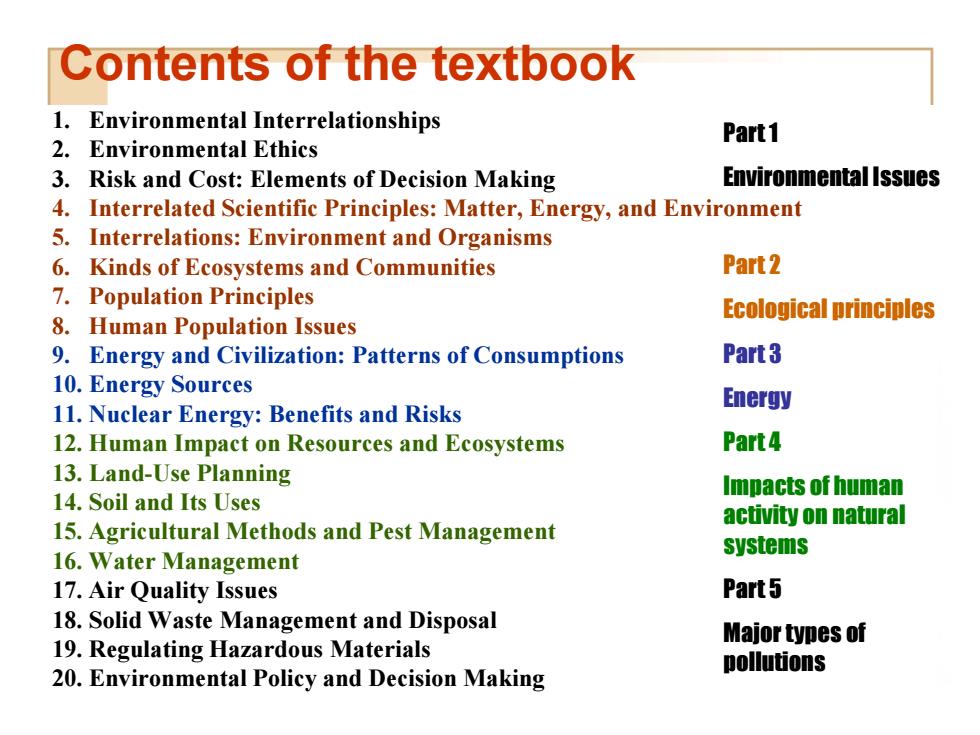
Contents of the textbook 1.Environmental Interrelationships 2.Environmental Ethics Part1 3.Risk and Cost:Elements of Decision Making Environmental Issues 4.Interrelated Scientific Principles:Matter,Energy,and Environment 5.Interrelations:Environment and Organisms 6.Kinds of Ecosystems and Communities Part2 7.Population Principles Ecological principles 8.Human Population Issues 9.Energy and Civilization:Patterns of Consumptions Part3 10.Energy Sources 11.Nuclear Energy:Benefits and Risks Energy 12.Human Impact on Resources and Ecosystems Part4 13.Land-Use Planning Impacts of human 14.Soil and Its Uses activity on natural 15.Agricultural Methods and Pest Management systems 16.Water Management 17.Air Quality Issues Part5 18.Solid Waste Management and Disposal 19.Regulating Hazardous Materials Major types of pollutions 20.Environmental Policy and Decision Making
Contents of the textbook 1. Environmental Interrelationships 2. Environmental Ethics 3. Risk and Cost: Elements of Decision Making 4. Interrelated Scientific Principles: Matter, Energy, and Environment 5. Interrelations: Environment and Organisms 6. Kinds of Ecosystems and Communities 7. Population Principles 8. Human Population Issues 9. Energy and Civilization: Patterns of Consumptions 10. Energy Sources 11. Nuclear Energy: Benefits and Risks 12. Human Impact on Resources and Ecosystems 13. Land-Use Planning 14. Soil and Its Uses 15. Agricultural Methods and Pest Management 16. Water Management 17. Air Quality Issues 18. Solid Waste Management and Disposal 19. Regulating Hazardous Materials 20. Environmental Policy and Decision Making Part 1 Environmental Issues Part 2 Ecological principles Part 3 Energy Part 4 Impacts of human activity on natural systems Part 5 Major types of pollutions

● In a broad definition,environment is every-thing that affects an organism during its lifetime. ● In turn,all organisms including people affect many components in their environment.From a human perspective,environment issues involve concerns about science,nature,health, employments,profits,politics,ethics,and economics
• In a broad definition, environment is every-thing that affects an organism during its lifetime. • In turn, all organisms including people affect many components in their environment. From a human perspective, environment issues involve concerns about science, nature, health, employments, profits, politics, ethics, and economics

Science of Sustainability Environmental From "Environmental Science to "Science of Sustainability"? Natural Sciences Social Science Economic Science
Natural Sciences Environmental Science Science of Sustainability Social Science Economic Science From “Environmental Science” to “Science of Sustainability”?
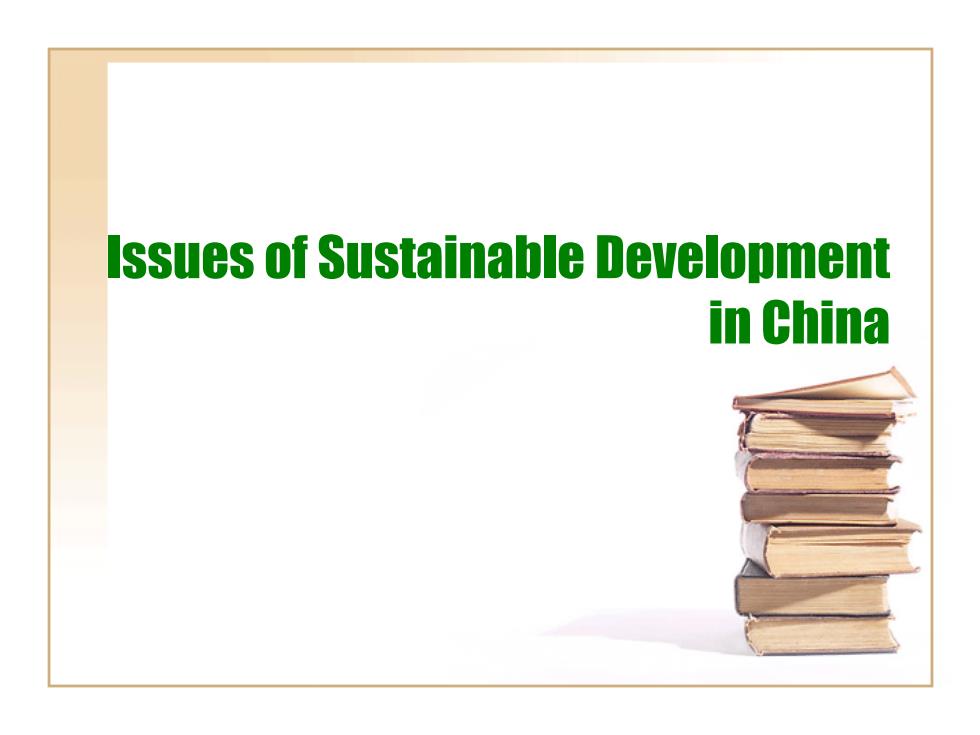
Issues of Sustainable Development in China
Issues of Sustainable Development in China

China is making a miracle F E A T U R E 2008 Who Will China Feed? yLohar G2 WAKE-UP CALL F0限A5WAL PLANET Lester R.Brown 1995 Alert Serles It is the great enthusiasm and power of people released after a long time of depression due to war and chaos,from a nation of glorious history and magnificent culture,but of a huge population,with the "Chinese model(?)",driving the development
It is the great enthusiasm and power of people released after a long time of depression due to war and chaos, from a nation of glorious history and magnificent culture, but of a huge population, with the “Chinese model(?) ”, driving the development. China is making a miracle 1995 2008

While 1400 population 1350 increased 1300 by nearly 1250 38%and to 1200 level off, GDP has 1150 increased 1100 nearly 25 1050 times. 1000 These achievements are obtained in a country of a huge 400 million population and by hard working and self reliance people have -◆-GDP in billion USD 6000 eradicated -。GDP per capita in USD poverty, 5000 which is 12 4000 years in advance 3000 on eradicating 2000 poverty for 1000 UN MDG 0 金家系罢竖豪多家竖墨多多墨鉴摹多星多鉴多烹赏赏膏美美葛囂司
While population increased by nearly 38% and to level off, GDP has increased nearly 25 times. 400 million people have eradicated poverty, which is 12 years in advance on eradicating poverty for UN MDG These achievements are obtained in a country of a huge population and by hard working and self reliance